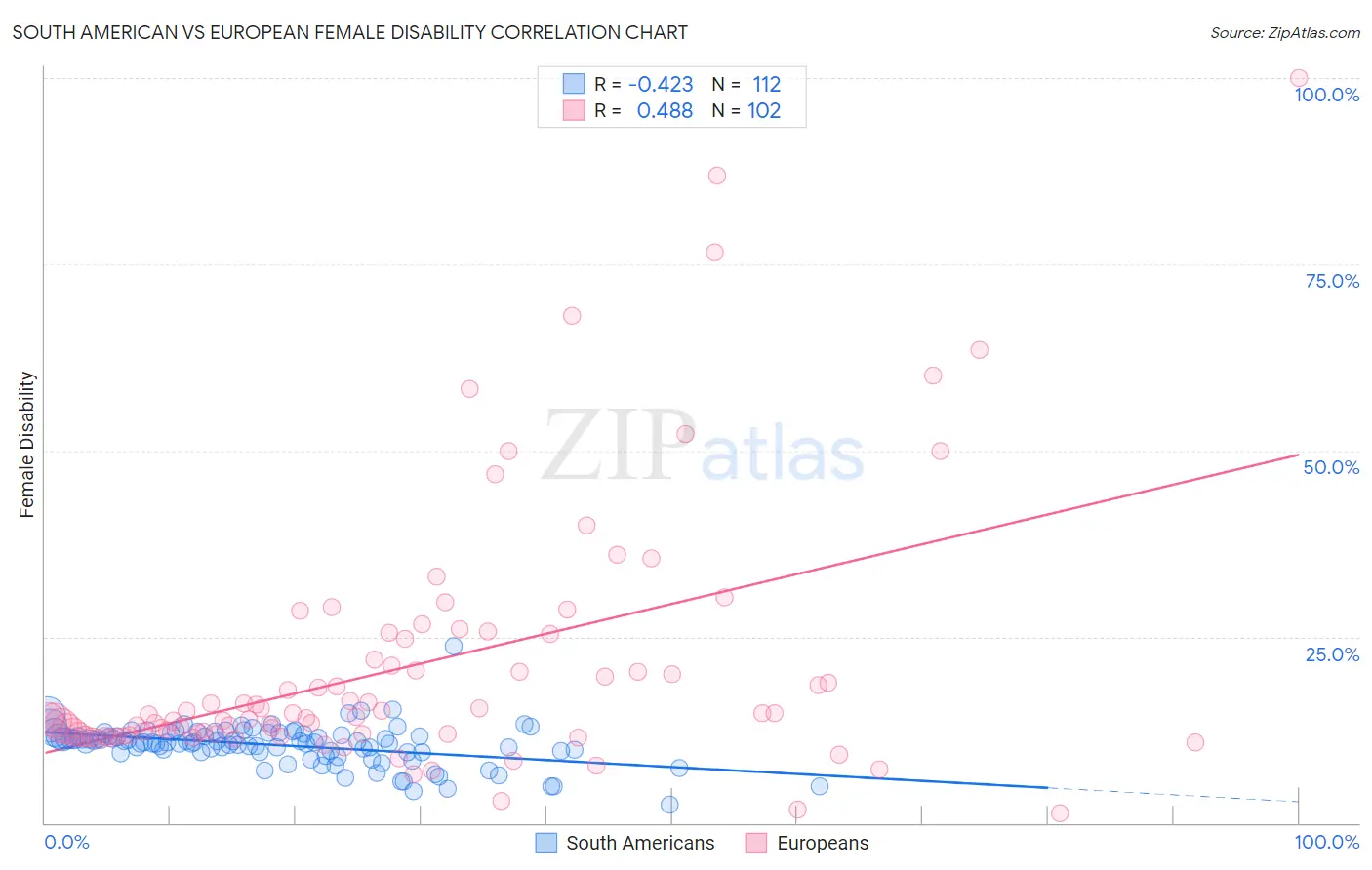South American vs European Female Disability
COMPARE
South American
European
Female Disability
Female Disability Comparison
South Americans
Europeans
11.4%
FEMALE DISABILITY
99.9/ 100
METRIC RATING
57th/ 347
METRIC RANK
12.4%
FEMALE DISABILITY
12.1/ 100
METRIC RATING
219th/ 347
METRIC RANK
South American vs European Female Disability Correlation Chart
The statistical analysis conducted on geographies consisting of 494,047,696 people shows a moderate negative correlation between the proportion of South Americans and percentage of females with a disability in the United States with a correlation coefficient (R) of -0.423 and weighted average of 11.4%. Similarly, the statistical analysis conducted on geographies consisting of 561,578,477 people shows a moderate positive correlation between the proportion of Europeans and percentage of females with a disability in the United States with a correlation coefficient (R) of 0.488 and weighted average of 12.4%, a difference of 9.2%.

Female Disability Correlation Summary
| Measurement | South American | European |
| Minimum | 2.5% | 1.3% |
| Maximum | 23.8% | 100.0% |
| Range | 21.3% | 98.8% |
| Mean | 10.4% | 21.2% |
| Median | 10.8% | 14.4% |
| Interquartile 25% (IQ1) | 9.5% | 11.9% |
| Interquartile 75% (IQ3) | 11.9% | 24.8% |
| Interquartile Range (IQR) | 2.4% | 12.9% |
| Standard Deviation (Sample) | 2.7% | 17.6% |
| Standard Deviation (Population) | 2.7% | 17.5% |
Similar Demographics by Female Disability
Demographics Similar to South Americans by Female Disability
In terms of female disability, the demographic groups most similar to South Americans are Laotian (11.4%, a difference of 0.020%), Taiwanese (11.4%, a difference of 0.080%), Immigrants from Spain (11.4%, a difference of 0.15%), Immigrants from Bulgaria (11.4%, a difference of 0.27%), and Bulgarian (11.3%, a difference of 0.31%).
| Demographics | Rating | Rank | Female Disability |
| Inupiat | 100.0 /100 | #50 | Exceptional 11.3% |
| Immigrants | Belgium | 100.0 /100 | #51 | Exceptional 11.3% |
| Immigrants | Peru | 99.9 /100 | #52 | Exceptional 11.3% |
| Immigrants | Saudi Arabia | 99.9 /100 | #53 | Exceptional 11.3% |
| Peruvians | 99.9 /100 | #54 | Exceptional 11.3% |
| Bulgarians | 99.9 /100 | #55 | Exceptional 11.3% |
| Taiwanese | 99.9 /100 | #56 | Exceptional 11.4% |
| South Americans | 99.9 /100 | #57 | Exceptional 11.4% |
| Laotians | 99.9 /100 | #58 | Exceptional 11.4% |
| Immigrants | Spain | 99.9 /100 | #59 | Exceptional 11.4% |
| Immigrants | Bulgaria | 99.9 /100 | #60 | Exceptional 11.4% |
| Immigrants | France | 99.9 /100 | #61 | Exceptional 11.4% |
| Sri Lankans | 99.9 /100 | #62 | Exceptional 11.4% |
| Immigrants | Colombia | 99.9 /100 | #63 | Exceptional 11.4% |
| Immigrants | El Salvador | 99.9 /100 | #64 | Exceptional 11.4% |
Demographics Similar to Europeans by Female Disability
In terms of female disability, the demographic groups most similar to Europeans are Immigrants from Bahamas (12.4%, a difference of 0.030%), British (12.4%, a difference of 0.050%), Bahamian (12.4%, a difference of 0.090%), Immigrants from Burma/Myanmar (12.4%, a difference of 0.10%), and Panamanian (12.4%, a difference of 0.11%).
| Demographics | Rating | Rank | Female Disability |
| Ute | 14.7 /100 | #212 | Poor 12.4% |
| Immigrants | Thailand | 14.5 /100 | #213 | Poor 12.4% |
| Panamanians | 13.5 /100 | #214 | Poor 12.4% |
| Samoans | 13.4 /100 | #215 | Poor 12.4% |
| Immigrants | Burma/Myanmar | 13.3 /100 | #216 | Poor 12.4% |
| British | 12.7 /100 | #217 | Poor 12.4% |
| Immigrants | Bahamas | 12.5 /100 | #218 | Poor 12.4% |
| Europeans | 12.1 /100 | #219 | Poor 12.4% |
| Bahamians | 11.1 /100 | #220 | Poor 12.4% |
| Native Hawaiians | 10.8 /100 | #221 | Poor 12.4% |
| Italians | 10.7 /100 | #222 | Poor 12.4% |
| Guamanians/Chamorros | 9.5 /100 | #223 | Tragic 12.5% |
| Belizeans | 9.3 /100 | #224 | Tragic 12.5% |
| Poles | 8.4 /100 | #225 | Tragic 12.5% |
| Hispanics or Latinos | 8.0 /100 | #226 | Tragic 12.5% |